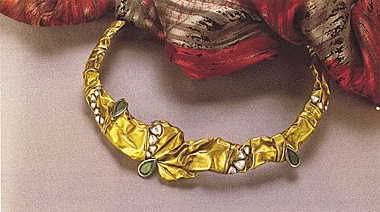
If you're new to Perfume Shrine's Chypre Series, please refer to the following basic articles:
What ARE "chypre perfumes"?
What are the aesthetics of chypre fragrances?
What's the history and zeitgeist of "chypre" evolution?
There are some chypre fragrances that got sidetracked for various reasons, none of which is the fault of their actual scent. Either their heyday ended in an abrupt change in the public's sensibilities or they fell out of production because of a deal that got terminated, or alternatively they became so low profile and obscure that they didn't pique the interest of the general public anymore. Notwithstanding that chance that they got reformulated beyond recognition. Whatever the reason, today's choices are great fodder for rediscoveries, much like a wild safari in the virtual jungle.

The jewel of the crown is the magnificent, transcedental chypre that was named and devised by none other than the perfumista par excellence, Catherine Deneuve. Her well established love of perfume blossomed into a creation she could call her own; first launched via an agreement with Avon for the US market (which might come as a surprise to some). However, according to her own admission in Elle magazine in 1994, that agreement fell through and the production stalled, maybe because greens were not so popular anumore, making Deneuve a sought after wonder of the online auctions even since.
She had personally been involved in its creation in France in 1986, "like a child in front of a magical toy", smelling hundreds of ingredients and combinations, eliminating (she hinted that the team creating it didn't really know what to do), testing the mods up till she settled for the final three ones. And then, on a shooting trip to Italy, she came up with the winning choice that materialised her vision: an "open" perfume, something that would be trully feminine, something classical and beautiful like a great piece of music, smelling like entering a garden which has an indefinable aroma. She wanted emotion, mystery, perhaps a bit of the Orient mixed in for good measure. {translated from quotes on French Marie Claire 1989}
I was moved by the brave sizlling top of green that combined intense galbanum with naturally eugenol-rich spicy basil, only to be awed upon coming across the lushness of the floral heart that spoke of warm smelling bouquets that rest on a mossy, sensual base that has a touch of the leathery animalic that is to be experienced in the drydown of classic chypre Miss Dior. It even came in a dusting powder which is so gloriously decadent and old-fashioned that I am stumped why it hasn't been featured in one of those highly successful commercially guides of how to become the perfect bombshell or something.
The downside? You must hunt it down on Ebay: be prepared for astronomical bids!
On the bright side, two dupes of it are reputed to be particularly spot on although I haven't tested them myself: Cannes from Long Lost perfumes (said to be a little sharp)and the Deneuve Type by DSH (said to be a tad richer)
Official notes for Deneuve:
Top: Green notes, Galbanum, Bergamot, Neroli, Basil, Aldehyde
Middle: Rose, Muguet, Jasmin, Orris, Ylang-Ylang, Violet, Hyacinth
Base: Moss, Musk, Cedarwood, Sandal, Civet
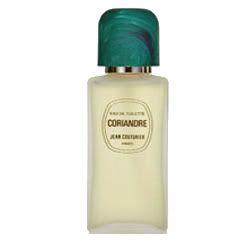
It first piqued my interest when I read Susan Irvine's desrciption of it: "fit for a red headed Raymond Chandler heroine". Perfume Shrine has long worshipped the noir heroines and their universe and this was like a bowl of cream in front of a hungry kitten: irresistible!
Subtle and refined, it didn't speak of the femme fatale so much, but of a patchouli and geramium wreath around roses of a dark red hue, an elegant missile of indoors denotation. Contrary to its name, it doesn't predominantly smell of coriander, although there is discernible spiciness to it that does not recall the culinary. The green pong of angelica makes it dry and somehow young despite appearences.
Created in 1973 by Couturier's own wife Jacqueline, who was Grasse-trained and an heir to perfumers, it was the foundation on which the Couturier Parfums brand was established. It comes in a bottle topped by a green malachite-looking cap, beautifully veined.
Coriandre has been a little surgically enhanced (this happened in 1993), but it didn't involve a complete face-lift which is good news to its acolytes. Consider yourself honoured and not humbled to be included in the latter.
Available from newsparfums.com and other etailers for reasonable prices.
Official notes for Coriandre:
Top: Coriander, Aldehydes, Angelica, Orange blossom
Middle: Rose, Geranium, Jasmine, Orris
Base: Patchouli, Sandal, Vetiver, Civet
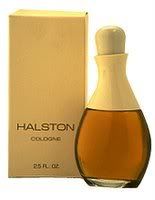
Halston by the american designer Roy Halston Fronwick stops at the Disco end of the Silk Road, being launched smack down in the middle of the 1970s decade (in 1975) in a bottle designed by Elsa Peretti, a designer famous for her "natural", organic shaped jewel designs for Tifanny. Those were the times that chypres were still in favour and its minty aroma that opens on green notes allied with marigold and bergamot, seguing to a lathery soapiness of orris, jasmine and rose touched with a little woodiness were alluring to the audiences of Studio 54. Then soapiness fell out of vogue and its vetiver-laden base with a slight smokiness of incense and moss to it was antithetical to the heavy drum n'bass of the 80s amber perfumes that dominated the corporate world, too busy to go dance recklessly under strobe lights.
Still, Halston manages to survive today as something that smells unique and invitingly warm. I was deeply surprised when Agapi Vardinoyiannis, the socialite wife of a tycoon, divulged casually upon being asked on the familiar smell emanating that it was her preferred signature scent. Surely a woman who can afford anything condoning this long-time forgotten little gem is enough motivation to seek it out.
Official notes for Halston:
Top:melon, green note, peach, bergamot, spearmint, marigold
Middle: jasmine, rose, cedar, orris, ylang ylang, carnation
Base: moss, patchouli, vetiver, amber, musk, sandalwood, incense
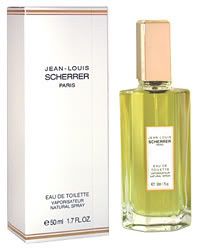
Jean Louis Scherrer (1979)by designer Jean Louis Scherrer is a precious sight in its elegant, tall hexagonal bottle that opens up to verdant glory of liquid emeralds. Green and with the rush of sparkling aldehydes it is soon intensly mossy and floral, recalling a bygone era. The violet note is mostly reminiscent of an iris fragrance, slightly metallic and otherwordly; but the brooding synergy with the other ingredients brings out a luminiscent aura that is tantamount to wearing an expensive necklace of Peruvian pre-Colombian emeralds set on antique gold.
It can be ordered from First in Fragrance/Aus liebe zum duft and Escentual as well as other etailers.
Official notes for Jean Louis Scherrer:
Top: aldehydes, cassis, violet, hyacinth
Middle: tuberose, jasmine, rose, gardenia, carnation
Base: sandalwood, vetiver, civet, moss.
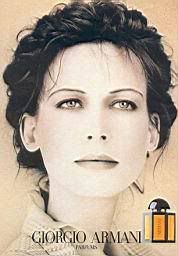
Last but not least, one of the first perfumes that I donned on my juvenile person and came to love, earning lots of compliments in the process and assuming poses well beyond my years was Armani Femme, the original scent that was issued in 1982. Perhaps more green than traditionally chypre, it came in a bottle trifaced like a byzantine triptych, which enchanted my historically bent soul. The aroma of greens merged with the powdery and lush whiffs of flowers and fruits that never became sweet. It was perfume-y and proud of it, asserting its persona beyond doubt with a warm, erotic base that surely made more promises than those delivered to my admirers back then.
Sadly discontinued in favour of newer blunt releases...Shame, mr.Armani, shame.
Official notes for Armani Femme :
Top: Spearmint, Galbanum, Pineapple, Marigold
Middle: Jasmine, Tuberose, Cyclamen, Narcissus
Base: Cedarwood, Oakmoss, Tonka, Benzoin
Pics courtesy of parfumsdepub,okadi,toutsurdeneuve, escentual and Greek jeweler Fanourakis
.jpg)

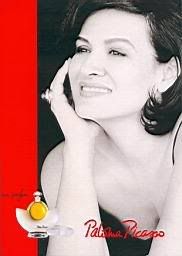


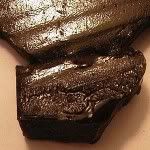
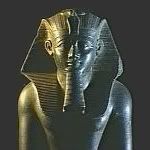
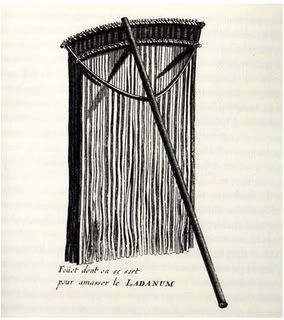





.jpg)

